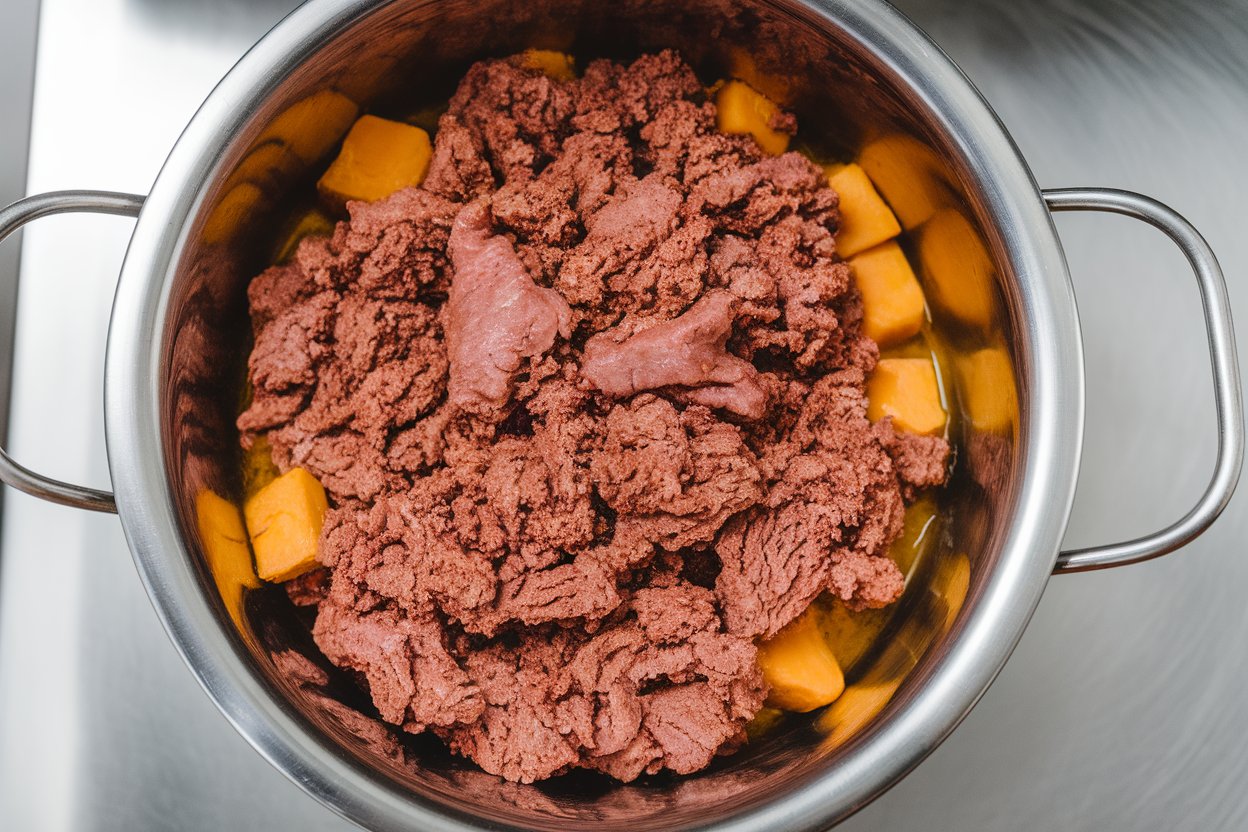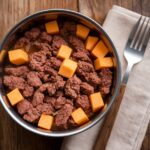Homemade Cat Meal With Beef: The Purrfect High-Protein Recipe Your Feline Will Actually Devour
You don’t need a culinary degree to make a cat meal that’s healthier, fresher, and way tastier than the bag of mystery crumbs in the pantry. If your feline turns up their nose at “chicken-flavor-ish,” this beefy bowl might be the cure.
We’re talking real ingredients, real nutrition, and a texture that says “gourmet,” not “sawdust.” Plus, you control the quality—no fillers, no weird byproducts, just clean fuel for a happy, zoomy cat.
Ready to level up your cat’s dinner game and look like the hero they think you are?
What Makes This Recipe Awesome
- High-protein and species-appropriate: Cats are obligate carnivores. This recipe uses beef as the primary protein to support muscle and overall health.
- Gentle on digestion: Lightly cooked beef with a small amount of fiber helps sensitive tummies without over-complicating the bowl.
- Hydration-forward: Added moisture supports urinary tract health, which your vet will appreciate even if your cat won’t send a thank-you note.
- Customizable: Easy to tweak for texture, fat level, and add-ons like sardine oil for omega-3s.
- Cleaner ingredient list: No artificial colors, preservatives, or mystery “meal.” Just real, whole-food components.
What Goes Into This Recipe – Ingredients
- 1 lb (450 g) ground beef, 90–93% lean (grass-fed if possible)
- 3 oz (85 g) beef liver, finely minced (do not exceed 10% of the total meat by weight)
- 1 large egg, lightly beaten (optional: use just the yolk for extra richness)
- 1/2 cup (120 ml) low-sodium beef bone broth or water (no onion, no garlic)
- 1 tsp fish oil or sardine oil (source of EPA/DHA omega-3s)
- 1/4 tsp taurine powder (critical amino acid for cats)
- 1/8 tsp iodized salt (for iodine; skip if you’re using a complete feline supplement with iodine)
- 1/2 tsp calcium source (eggshell powder or food-grade calcium carbonate; aim for ~1,000–1,200 mg calcium per lb of meat)
- 2 tbsp finely pureed pumpkin or cooked carrot (optional fiber; keep minimal)
- 1 tbsp finely chopped parsley (optional, very small amount for freshness)
- Optional complete feline vitamin/mineral premix designed for homemade cat food; follow label dosage if used (this can replace individual taurine/iodine/calcium additions)
Important: Cats need balanced diets. If you’re feeding homemade regularly (not just as a topper), a complete feline supplement is strongly recommended to cover vitamins A, D, E, K, B-complex, copper, zinc, and manganese requirements.
Instructions
- Prep your space: Wash hands, clean surfaces, and set out mixing bowls.Cats are tough, but food safety still matters.
- Lightly cook the beef: In a skillet over medium heat, cook the ground beef until just browned on the outside, still slightly pink in spots. Do not overcook.
- Add liver gently: Stir in the minced liver for the last 1–2 minutes of cooking. Liver cooks fast—keep it tender.
- Cool it down: Remove from heat and let the meat cool until warm, not hot.We’re not making beef sauna.
- Blend the moisture: In a small bowl, whisk the bone broth/water with fish oil, taurine, calcium, and salt (or use your premix per instructions). Add the egg or yolk and whisk until smooth.
- Combine: In a large bowl, mix the warm meat with the liquid mixture. Fold in pumpkin puree and parsley if using.The texture should be moist, scoopable, and not crumbly.
- Taste-check (for you, visually): No actual tasting, chef. Ensure there are no bone fragments and the mixture smells fresh.
- Portion: Divide into daily servings—typically 2–3 ounces (55–85 g) per meal for an average adult cat, but adjust per your vet’s guidance and your cat’s body condition.
- Serve: Offer slightly warm or room temp. Many cats snub cold meals straight from the fridge, because of course they do.
Preservation Guide
- Refrigerate: Store in airtight containers for up to 48–72 hours.
- Freeze: Portion into silicone molds or small containers.Freeze up to 2–3 months for best quality.
- Safe thawing: Thaw in the fridge overnight or in a sealed bag under cold running water. Never leave out at room temperature beyond 1–2 hours.
- Reheating: Warm gently in a water bath or brief microwave burst (low power), stirring well. Avoid hot spots.
What’s Great About This
- Control over ingredients: You choose the quality and fat level and skip the fillers.
- Supports hydration: Extra moisture helps keep the urinary tract happy.Less drama at the litter box, IMO.
- Palatability: Beef aroma is strong and enticing for picky eaters.
- Scalable: Make a big batch on Sunday and portion for the week. Your future self says thanks.
Common Mistakes to Avoid
- Skipping taurine or calcium: Non-negotiable. Taurine deficiency can cause serious heart and eye issues; calcium balances phosphorus.
- Overdoing liver: Keep liver to ~5–10% of total meat.Too much can cause vitamin A toxicity over time.
- Using seasoned broths: No onion, garlic, or high sodium. These can be harmful to cats.
- Dry texture: Cats often reject crumbly, dry food. Add more broth or water to reach a moist, soft consistency.
- All-in sudden switch: Transition gradually over 5–7 days to avoid tummy upsets.
Alternatives
- Protein swap: Use turkey thigh, chicken, or rabbit if beef isn’t your cat’s jam.Keep the same ratio and supplement plan.
- Raw-leaning approach: If you feed raw, consult your vet and a veterinary nutritionist for safe handling and complete balancing. Light sear the outside if you want a middle ground.
- Omega options: Substitute fish oil with krill oil or add a tiny amount of canned sardines in water (no salt added).
- Fiber tweaks: If constipation shows up, increase pumpkin slightly; if stools are too soft, reduce fiber and ensure adequate calcium.
- Premix shortcut: Use a reputable feline vitamin/mineral premix to ensure balance without juggling individual supplements.
FAQ
Is this recipe complete and balanced for daily feeding?
It can be, but only if you include the proper supplements at the right dosages. For simplicity and safety, use a feline-specific premix designed for beef-based recipes or consult a veterinary nutritionist.
Without supplements, use it as a topper, not the full diet.
Can kittens eat this?
Yes, but kittens have higher energy and nutrient needs. You’ll need a complete and balanced formulation specifically for growth, with correct calcium, phosphorus, and vitamins. Work with your vet and consider a growth-appropriate premix.
Is beef safe for cats with sensitive stomachs?
Often, yes—especially when lightly cooked and paired with moisture.
However, some cats do better with poultry or novel proteins. Start with small portions and watch for vomiting, diarrhea, or itchiness. When in doubt, talk to your vet.
Can I skip the liver?
Liver provides critical nutrients (vitamin A, B vitamins, copper).
If you skip it, you must compensate using a complete premix or targeted supplements. Don’t just remove it and hope for the best.
How much should I feed per day?
As a ballpark, many adult cats eat roughly 20–30 calories per pound of body weight per day. This recipe averages around 35–45 kcal/oz depending on fat level.
Start with 2–4 ounces per day for a 10-lb cat, split into two meals, then adjust to maintain ideal body condition.
Is garlic or onion powder okay for flavor?
No. Garlic and onion (and their powders) are toxic to cats and can damage red blood cells. Keep them out of all feline recipes—no exceptions.
What if my cat won’t eat it?
Warm it slightly, add a tiny sprinkle of crushed freeze-dried beef treats, or mix a spoonful into their regular food.
Transition slowly over 5–7 days. Some cats are dramatic; patience usually wins.
Can I use bone broth from the store?
Only if it’s truly plain and low-sodium with no onion, garlic, leeks, or chives. When in doubt, use water or make your own pet-safe broth.
Final Thoughts
Homemade Cat Meal With Beef gives you control, clarity, and a highly palatable dish your feline overlord will actually eat.
Keep it moist, keep it balanced, and keep supplements on point. Whether you’re feeding it as a full meal (with a proper premix) or as a topper, this recipe turns dinner into a win-win: better nutrition for your cat, and fewer side-eye glares for you. FYI, once your cat decides this is “their” recipe, you might be making it on repeat—so go ahead and double the batch like a pro.

I’ve spent 10+ years in dog training, digging into what makes dogs (and their humans) tick. At Smart Dog Learning, I share my no-nonsense, fun approach to training so you can enjoy life with a well-behaved, happy pup—no boring lectures, just practical results 😉





